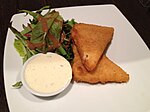Lemovician people
Menditaŕak Menditarrak | |
|---|---|
 Lemovician cultural celebration with children | |
| Total population | |
| ~5,000,000 | |
| Regions with significant populations | |
| 968,497 | |
| 199,061 | |
| 73,602 | |
| 51,712 | |
| 9,797 | |
| Languages | |
| Lemovician and Miersan | |
| Religion | |
| Episemialism, historically paganism | |
The Lemovicians (Lemovician: Menditaŕak, Menditarrak, sing. Menditaŕa, Menditarra) are a Euclean ethnic group and indigenous people native to Lemovicia and its immediate border regions in Miersa and Champania.
History
Evidence of habitation of present-day Lemovicia dates back between 16,000 BCE and 12,500 BCE, with many Lemovicians claiming that they are the descendants of the proto-Euclean inhabitants who resided in Lemovicia. However, the exact origins of the Lemovicians are unclear, although it is known that they were referred in the Solarian Empire as the Menes.
(TBC)
Culture
Art
Cuisine
Traditionally, Lemovician cuisine is dictated by the geography of Lemovicia. The most popular Lemovician foods eaten as part of a meal include śeŕa and gazta gogoŕa, as well as solomo, while the most popular desserts are gośoa and ospakizun.
However, due to the geography of the country, there is considerable variation between the highlands and lowlands in terms of Lemovician cuisine. In the highlands, for example, corijak aŕaucarekin is consumed, while in the lowlands, coriak kiśona is consumed. Bread is also far more present in lowland Lemovician cuisine than in highland Lemovician cuisine.
Traditionally, Lemovicians have two main meals: breakfast (Lemovician: gosarija, gosaria), which is the most important meal of the day, and traditionally consumed around dawn, and dinner (afarija, afaria), consumed around sunset, with a light meal, or tea (mokadu) consumed around noon. However, as globalisation reaches Lemovicia, Lemovicians are starting to have three meals a day.
Religion
Prior to the arrival of Sotirianity in Lemovicia, the Lemovicians followed a traditional religion. However, following the arrival of Sotirianity, the Lemovicians were heavily influenced by Arcilucan rites, to the point that after the Lesser Schism in 1385, Lemovician elites tended towards Episemialism. However, peasants were more influenced by Llorlainism, with Llorlainism being predominant until the sixteenth century.
Today, many Lemovicians are adherents to the Episemialist Church, with Episemialism playing an influential role in shaping Lemovician culture and identity. In West Miersa, most Lemovicians are part of the Miersan Episemialist Church, while in Lemovicia, while irreligion has been growing among Lemovicians, due to Lemovicians becoming sceptical of organised religion, most religious Lemovicians are part of the Lemovician Episemialist Church.
Society
Lemovician society is traditionally characterised by a system of clans (Lemovician: ahaida, plural: ahaide), with each clan traditionally based off a central baseŕi, with further baserria being established as the clan grew in size and stature.
Inheritance was traditionally patrilineal, with the eldest son inheriting the baseŕi, and all younger sons inheriting any other properties owned by that branch of the clan. Over time, as clans grew in size, younger sons are forced to split off from their native clan and either join a new clan (usually those of their wives), or establish their own clan.
Clans would traditionally support "daughter clans" that were established, with daughter clans being obligated to protect and defend the "honour" of the "maternal clan," in addition to assisting the daughter clans, in exchange for the maternal clan doing the same for the daughter clans. However, if a daughter clan grew large enough that it could establish its own "daughter clans," the maternal clan had no obligation of supporting the "granddaughter clans." Thus, to prevent inbreeding, marriage between maternal and daughter clans were forbidden, as well as between members of the same clan, although marriage between a maternal and a granddaughter clan would be allowed. However, Lemovicians practiced cultural endogamy.
Sports
Traditionally, Lemovicians played traditional Lemovician sports, with the most popular traditional sports that continue to be played by the Lemovician community including haŕi-jasocailejak, sokatira, oilar jokoa, and the national sport of Lemovicia, pilota.
However, due to rule by foreign powers, such as Miersa and Soravia, sports such as basketball, ice hockey, and football have gained popularity among the Lemovician community.

